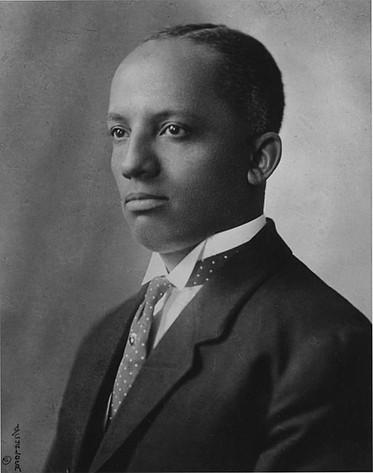Carter G. Woodson and Black Coal Miners in Nuttallburg, West Virginia
Introduction
Text-to-speech Audio
This is the approximate location of a small canteen that served African American coal miners in Nuttalburg. The location is historically significant for many reasons, including its formative influence on Dr. Carter G. Woodson, a West Virginia miner known today as "The Father of Black History" for his work establishing what is now Black History Month, The Association for the Study of African American Life and History, and the Journal of African American History. At the age of seventeen, Carter G. Woodson moved to Nuttallburg with his brothers to earn money for schooling. He worked several years at Nuttallburg and the nearby Kaymoor mine, and it was here where Oliver Jones, the operator of a small canteen that served the needs of Black coal miners made young Woods a deal. Mr. Jones had amassed many books and subscribed to African American newspapers such as the Chicago Defender, but his reading skills and those of most of his patrons were less substantial than Woodson's mastery of the written word. As a result, the owner offered his food to Woodson in exchange for reading the latest news to the miners along with works from his library which included books on Black history, art, and culture. Woodson referred to Jone's small establishment as a tearoom that was also a veritable reading room, and he credited his experiences here as furthering his interest in the study and teaching of Black history. After graduating high school and teaching in Huntington, Woodson earned a Bachelor of Literature degree from Berea College, partly through coursework at the University of Chicago. Woodson later returned to the southern coalfields of West Virginia for a short time, teaching school in the town of Winona. Woodson went on to become the second African American to earn a Ph.D. at Harvard University and became one of the most influential scholars of the 20th century.
Images
In this image of miners in Nuttallburg, several Black miners can be seen on the left of the photo.

Carter G. Woodson saved money while working in the Nuttallburg mines and was eventually able to graduate from Harvard University with a PhD in history.

Backstory and Context
Text-to-speech Audio
African Americans made up a large part of the workforce in mines throughout the New River area with many arriving from Southern states south seeking a better life. To be sure, the advertising campaigns of coal companies and the professional labor recruiters spurred southern Black men and families to move to the coalfields. Nuttallburg was one of the many towns that recruited African American laborers. The town, however, was segregated and maintained separate schools, churches, and other facilities. White residents lived on the west side of the river while Black residents lived on the east side and between the railroad tracks and river. Despite being segregated, African Americans were able to earn a relatively decent living in the New River area.
Sources
Nuttallburg Visitor Use Area Implementation Plan/Environmental Assessment, National Park Service. January 1st 2011. Accessed May 4th 2021. http://nuttallfamilywv.com/wp-content/uploads/2013/02/CD-Nuttallburg-IP-EA-November-2008.pdf.
Trotter, William Joe. Jr. Coal, Class, and Color: Blacks in Southern West Virginia, 1915-32. Chicago: University of Illinois Press, 1990.
Walsh, Rita. Nuttallburg Coal Mining Complex and Town Historic District, National Register of Historic Places. May 1st 2005. Accessed May 4th 2021. http://www.wvculture.org/shpo/nr/pdf/fayette/07000846.pdf.
Carter G. Woodson: Winona, WV, National Park Service, New River Gorge. February 3rd 2017. Accessed December 29th 2021. https://www.nps.gov/neri/planyourvisit/carter-g-woodson-winona-wv.htm.
“Coal Miners at Nuttallburg.” National Park Service. Accessed May 4th 2021. https://www.nps.gov/neri/planyourvisit/african-american-life-in-a-coal-camp-nuttallburg.htm.
Carter G. Woodson. Wikimedia. Accessed May 4th 2021. https://commons.wikimedia.org/wiki/File:Dr._Carter_G._Woodson_(1875-1950),_Carter_G._Woodson_Home_National_Historic_Site,_1915._(18f7565bf62142c0ad7fff83701ca5f6).jpg.
